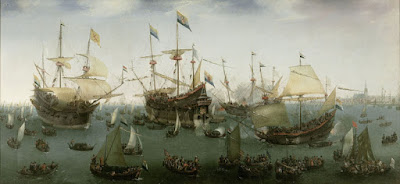Trade has been with us for longer than we have written records. We trace it through art and craft.
 |
|
The Meagre Company, 1633-37, Frans Hals and Pieter Codde. Courtesy Rijksmuseum, Amsterdam. One of the most important Asian imports to Europe was silk.
|
We think of global trade as a modern phenomenon, but trade has been part of human civilization since long before there were written records. Artwork is a primary tool for tracking that.
Glass beads were a high-status item in the late Bronze Age. Their manufacture was restricted to Egypt and Mesopotamia and traded as finished goods. By 1300 BC, raw glass itself was in international trade. The oldest glass ingots on trade routes were found in a 1300 BC shipwreck off the coast of Turkey.
 |
|
The Riace Warriors, Greek, c. 460-50 BC, discovered in the sea off Calabria, Italy.
|
Egypt didn’t invent this process, but it controlled it. All three ancient-world glass furnaces for raw ingot manufacture were in Egypt. This is where cobalt Egyptian blue glass and copper-based red glasses were first made. The Amarna Letters (c. 1350 BC) detail the military and other relationships between Egypt and its vassal states in Syro-Palestine; they contain frequent requests for glass. Glass beads were nearly as precious as gold and silver.
By the eighth century BC, the Greeks and Etruscans were part of an active trade network around the Aegean and Mediterranean. One side effect was the Orientalizing of Greek art. Massive imports of raw materials and an influx of foreign craftsmen introduced new skills into Greece. Its influence was felt in Italy, Sardinia and the Iberian Peninsula. This trade network expanded to include the entire Mediterranean. Greek pottery has been found in Marseilles and Carthage to the west, Crete to the south and Sardis to the East.
 |
|
Saint Jerome in his Study, 1480, fresco, Domenico Ghirlandaio, courtesy chiesa di Ognissanti, Florence.
|
The Roman Empire was built upon trade. No tariffs, a common currency, and secured trade routes led to world domination. They imported raw materials from as far as Britain to the west, Asia (along the Silk Road) to the east, and from Germanic and Slavic tribes far outside the empire. In return they exported Roman culture. Today we find Roman ruins, roads, coins, and mosaics across Europe.
When the Roman Empire was snuffed out, so were their trade networks. Trade was controlled by the Caliphates until the Renaissance. This brought middle eastern art into Iberia, but cut Europeans off from Asia and Africa. These networks weren’t restored until the Age of Sail.
A fifteenth-century painting by Domenico Ghirlandaioof St. Jerome is a map of contemporary global trade. The oriental carpet, glazed albarelli (drug jars) and crystal vases were all trade goods at the time. Note his spectacles, invented in Florence in the 13th century.
 |
|
Adoration of the Magi, c. 1495–1505, distemper on linen, Andrea Mantegna, courtesy of the Getty.
|
In Giovanni Bellini’s The Feast of the Gods, there is blue-and-white Chinese porcelain, painted from the family collection of the patron, the Duke of Ferrara. Porcelain from the same collection is visible in Andrea Mantegna’s Adoration of the Magi, c 1500. The reservation of porcelain to gods and princes tells us just how precious it was.
In 1603, the Dutch seized a Portuguese carrack off the coast of Singapore. Its manifest is a record of the goods then being traded with Asia: 1,200 bales of raw silk, many chests of damasks and embroideries, innumerable sacks of spices and sugar, and 60 tons of porcelain.
 |
|
The Return to Amsterdam of the Second Expedition to the East Indies, 1599, oil on canvas, Hendrik Courtesy Rijksmuseum, Amsterdam.
|
By the 16th century, the Netherlands was the center of free trade, which now ranged across the world. This can be seen in images of the boats they used, and the goods they brought home, including silk, spices, sugar and fruits.

